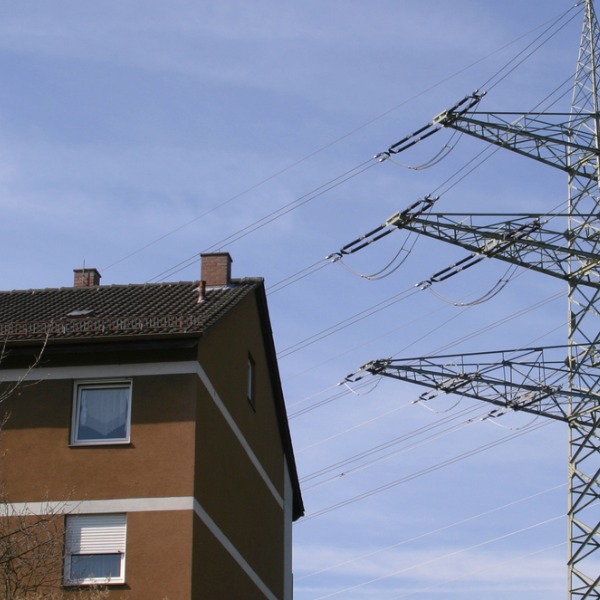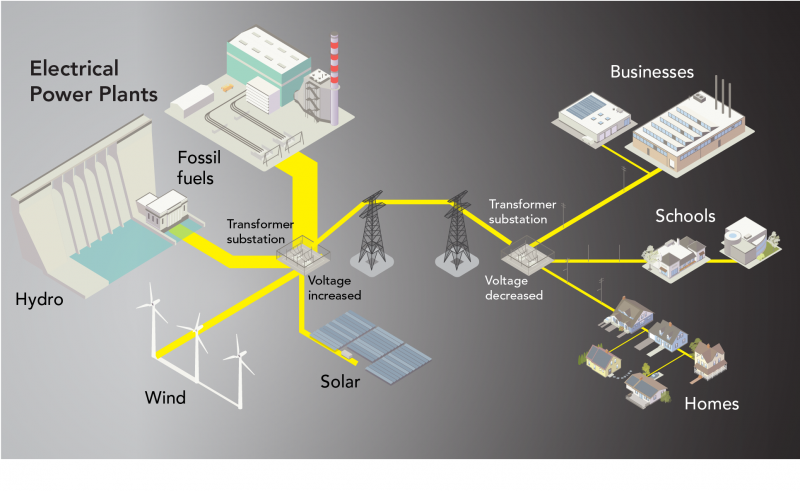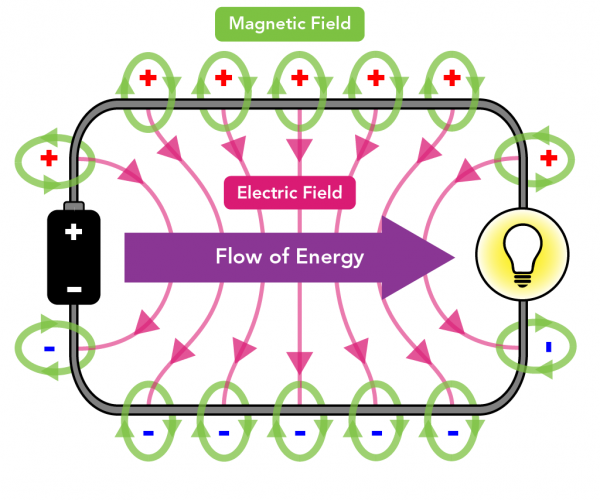Does Living Near High-Voltage Power Lines Cause Cancer?

Electrical power lines near a home (hohl, iStockphoto)

Electrical power lines near a home (hohl, iStockphoto)
How does this align with my curriculum?
| Grade | Course | Topic |
|---|
Learn about the risks of electromagnetic radiation near high-voltage power lines.
Every day, you use technologies that you probably take for granted. Things like the microwave that cooks your meals, the lights that let you see in the dark and the television that entertains you. What do these technologies have in common? They all need electricity to work.
Our need for electricity is growing. So is the number of transmission towers and overhead electrical wires in the places we live. But what if spending time near the electrical and magnetic energy from high-voltage wires causes health problems? Thankfully, research indicates that it probably doesn’t. At least not in the case of childhood leukemia.
High-voltage overhead transmission lines carry electricity from electrical power plants to transformer substations. Transformer substations are closer to where the electricity is actually used.

Power lines are surrounded by an electromagnetic field (EMF) that stretches in all directions. The US National Cancer Institute (NCI) describes electromagnetic fields as “invisible areas of energy (also called radiation) that are produced by electricity”. The NCI also explains that EMFs are produced by many things, like power lines, electrical wiring and household appliances like televisions and microwaves.
Electromagnetic fields combine electric fields and magnetic fields.
| Electric Fields | Magnetic Fields |
|---|---|
| Produced by voltage | Produced by current |
| The higher the voltage, the stronger the field | The greater the current, the stronger the field |
| Exists even when there is no current flowing | Strength of field varies with power consumption |
| Field can do work (the speed and direction of particles changes) | Field cannot do work (speed of particles remain constant) |
| Are perpendicular to the magnetic field | Are perpendicular to the electric field |
| Symbol is E | Symbol is B |
| Measured in volts per metre (V/m) or Newton/coulomb |
Measured in tesla (T) (Newton × Second) /(Coulomb × Meter) |
| Measured using electrometer | Measured using magnetometer |
Based on a chart by EMsafety

Illustration - Text Version
Electric field lines are directed away from positively charged source charges and toward negatively charged source charges. Magnetic field lines form circular loops around the wire. The flow of energy is directed through the fields from the dry cell towards the load (light bulb).
The EMFs that come from high-voltage power lines are a lot stronger than those around household appliances. Household appliances usually produce fields measuring between 0.01 to 0.02 microteslas (µT). If you stood directly underneath the highest voltage power lines though, you could receive a maximum of 100µT. That is 10 000 times as much.
This amount quickly decreases as you move away from high voltage lines. For example, at 25 m away from the most powerful line you would receive about 1-2µT. This is still ten to 20 times more exposure than you would get inside the average home in North America.
Where you live in the world probably makes a big difference to the EMFs you receive. People living far from the earth’s magnetic poles receive on average 30µT. People in Canada live closer to the North geomagnetic pole, and can receive up to 60µT.
Did you know?
The tesla (T) is the SI (International System of Units) unit used to describe the strength of magnetic fields. It can also be represented as kg⋅s−2⋅A−1. Scientists normally report data in millionths of a tesla, or microteslas (µT).
Some people living near high-voltage power lines worry about possible health effects. One worry is that children could have a higher risk of getting cancer as a result of living near a power line.
Did you know?
Magnetic fields are more likely to penetrate the body than electric fields. Electrical fields are weakened by obstacles like walls. Because of this, magnetic fields are the part of electromagnetic fields (EMFs) that are often studied as a possible cause of cancer.
Scientists have done many studies on this subject. In 2018, a group of scientists studied all the results of 11 previous studies around the world. They found that there was no clear link between magnetic fields and a child’s chance of developing leukemia, a kind of cancer. They looked at children who lived close to and far away from power lines of all voltages. They found almost no differences between them.
One difference they did find was that children who lived very close to high voltage lines had a very small increase in their chances of developing leukemia. This didn’t always happen though. And children living near stronger magnetic fields did not have a stronger chance of developing leukemia. So, scientists don’t know what causes this problem.
Childhood cancer doesn’t happen very often. So, it’s difficult to measure if this number is changing, even a little bit. In Canada, 1,230 children were diagnosed with leukemia between 2012 and 2016.
We are exposed to EMFs all the time. From power lines and appliances to where you live on the Earth. The field of research into the health impacts of EMFs is still fairly new. Scientists still have many questions and a lot to learn about how EMFs from different sources can affect our health.
Starting Points
- Do you feel safe when near high voltage power lines?
- Would the presence of high voltage power lines play a role in your decision to buy/construct a house? Discuss.
- Household and electronic appliances all produce EMF. Does this article make you feel more or less confident about the safety guidelines related to these devices? Why or why not?
- Should governments impose regulations for builders when building houses near high voltage power lines? Why or why not?
- Explain how energy consumption would have an impact on the amount of EMF produced in a residential area.
- Can other technologies such as solar energy limit the amount of EMFs produced from high voltage power lines? Discuss.
- Are children more susceptible to risks associated with EMFs than adults? Why or why not?
- What is the maximum recommended level of EMF exposure for children? Adults? Where can someone find this information?
- How do EMFs differ from radiation such as x-rays and nuclear radiation?
- What are the known causes of leukemia? (Use the Learn More section to do some research)
- What role do new technologies play in increased EMFs?
- Why are multiple studies required when determining the effects of EMFs on human health?
- Should we depend on the development of new technology to help solve the problems associated with EMFs? Explain.
- Science is said to be a collaborative social process. Explain why this is true with reference to this article.
- What aspects of EMFs and high voltage power lines do media outlets discuss? Is the discussion provided too narrow in scope? Why or why not?
- Consumerism is said to be a leading factor for the increased need for energy. What is consumerism and how do popular media contribute to a culture of consumerism?
- How should government agencies and media outlets communicate the potential health risks associated with EMFs?
- Do you feel that potential health risks related to EMFs are effectively communicated to residents?
- This article supports teaching and learning of Health, Technology & Engineering, Physics and Electricity and Magnetism related to cancer, electric fields and electricity transmission. Concepts introduced include magnetic fields, electric fields, electricity and Tesla (T).
- After reading this article, students could summarize and consolidate their understanding of the article content using a Key Ideas Round Robin learning strategy. Ready-to-use Key Ideas Round Robin reproducibles for this article are available in [Google doc] and [PDF] formats.
- After reading this article, students could practice their critical thinking skills by using a Claim, Evidence, Challenge learning strategy. Ready-to-use Claim, Evidence, Challenge reproducibles for this article are available in [Google doc] and [PDF] formats.
- To focus on the STSE issues of electromagnetic fields, teachers could have students use an Issues & Stakeholders learning strategy to consider the perspectives of different community members related to the development of a new housing development in close proximity to large electricity transmission towers. Ready-to-use Issues & Stakeholders reproducibles for this article are available in [Google doc] and [PDF] formats.
Connecting and Relating
- Do you feel safe when near high voltage power lines?
- Would the presence of high voltage power lines play a role in your decision to buy/construct a house? Discuss.
- Household and electronic appliances all produce EMF. Does this article make you feel more or less confident about the safety guidelines related to these devices? Why or why not?
Relating Science and Technology to Society and the Environment
- Should governments impose regulations for builders when building houses near high voltage power lines? Why or why not?
- Explain how energy consumption would have an impact on the amount of EMF produced in a residential area.
- Can other technologies such as solar energy limit the amount of EMFs produced from high voltage power lines? Discuss.
Exploring Concepts
- Are children more susceptible to risks associated with EMFs than adults? Why or why not?
- What is the maximum recommended level of EMF exposure for children? Adults? Where can someone find this information?
- How do EMFs differ from radiation such as x-rays and nuclear radiation?
- What are the known causes of leukemia? (Use the Learn More section to do some research)
Nature of Science/Nature of Technology
- What role do new technologies play in increased EMFs?
- Why are multiple studies required when determining the effects of EMFs on human health?
- Should we depend on the development of new technology to help solve the problems associated with EMFs? Explain.
- Science is said to be a collaborative social process. Explain why this is true with reference to this article.
Media Literacy
- What aspects of EMFs and high voltage power lines do media outlets discuss? Is the discussion provided too narrow in scope? Why or why not?
- Consumerism is said to be a leading factor for the increased need for energy. What is consumerism and how do popular media contribute to a culture of consumerism?
- How should government agencies and media outlets communicate the potential health risks associated with EMFs?
- Do you feel that potential health risks related to EMFs are effectively communicated to residents?
Teaching Suggestions
- This article supports teaching and learning of Health, Technology & Engineering, Physics and Electricity and Magnetism related to cancer, electric fields and electricity transmission. Concepts introduced include magnetic fields, electric fields, electricity and Tesla (T).
- After reading this article, students could summarize and consolidate their understanding of the article content using a Key Ideas Round Robin learning strategy. Ready-to-use Key Ideas Round Robin reproducibles for this article are available in [Google doc] and [PDF] formats.
- After reading this article, students could practice their critical thinking skills by using a Claim, Evidence, Challenge learning strategy. Ready-to-use Claim, Evidence, Challenge reproducibles for this article are available in [Google doc] and [PDF] formats.
- To focus on the STSE issues of electromagnetic fields, teachers could have students use an Issues & Stakeholders learning strategy to consider the perspectives of different community members related to the development of a new housing development in close proximity to large electricity transmission towers. Ready-to-use Issues & Stakeholders reproducibles for this article are available in [Google doc] and [PDF] formats.
Learn more
An illustrated overview from the University of Alicante of where the earth’s magnetic field comes from, its strength in different places, the forces from outer space that affect it and more.
Electromagnetic fields: health effects
This section of a World Health Organization's site explains briefly a variety of health concerns about electromagnetic fields and why so far the WHO is not worried.
Article from the Canadian Cancer Society outlines what we know about EMFs and cancer.
Radiation and Health: Power lines and electrical appliances
Article from the Government of Canada that explains why Heath Canada does not consider nearness to power lines a health risk.
Risk factors for childhood leukemia
This page from the Canadian Cancer Society outlines the known and possible risks of childhood leukemia.
Hydro Québec web page that shows a variety of different transmission towers and what each is used for.
Watch the Strongest Indoor Magnetic Field Blast Doors of Tokyo Lab Wide Open (2018)
Description from SmartNews of the biggest magnetic field generated on earth - 1200 teslas - and a video (0:10 min.) of the damage to the lab when it happened.
References
Amoon, A. T., Crespi, C. M., Ahlbom, A., Bhatnagar, M., Bray, I., Bunch, K. J., … Kheifets, L. (2018). Proximity to overhead power lines and childhood leukaemia: an international pooled analysis. British Journal of Cancer, 119(3), 364–373. DOI: 10.1038/s41416-018-0097-7
Crespi, C. M., Swanson, J., Vergara, X. P., & Kheifets, L. (2019). Childhood leukemia risk in the California power line study: Magnetic fields versus distance from power lines. Environmental Research, 171, 530-535. DOI: 10.1016/j.envres.2019.01.022
Diffen. (n.d.). Electric field vs. magnetic field.
Hobbs, B. (n.d.). Are we teaching electricity the wrong way around? ABC Science.
National Cancer Institute. (n.d.). Electromagnetic fields and cancer.
World Health Organization. (n.d.). What are electromagnetic fields?